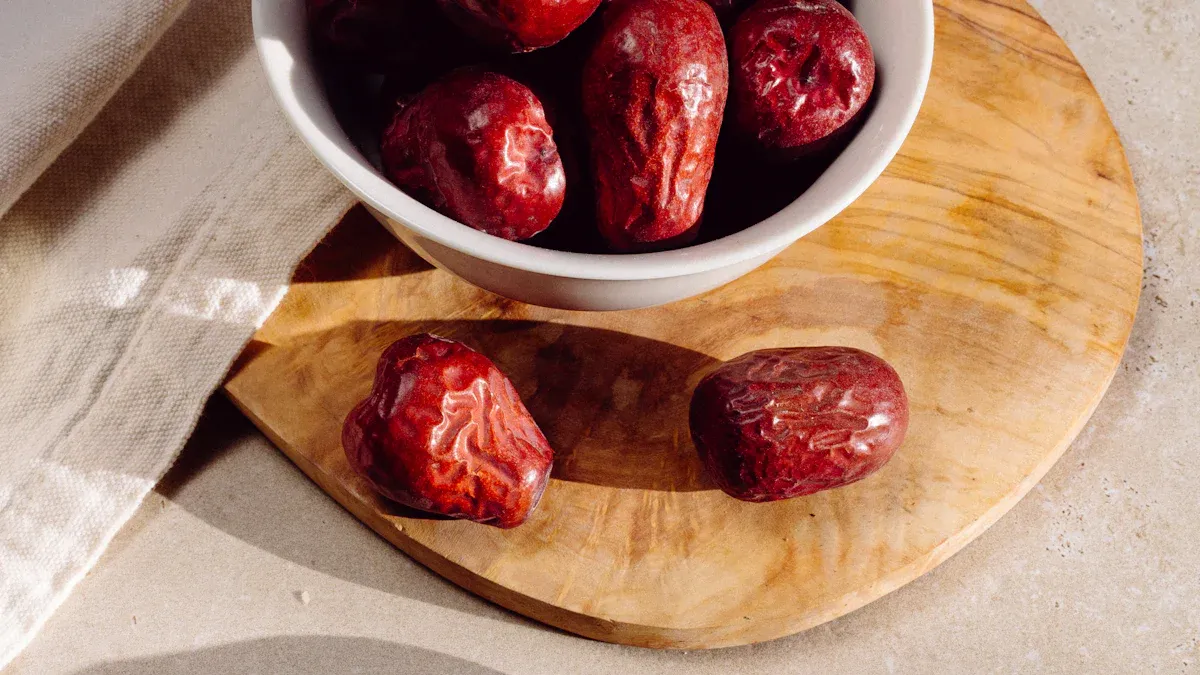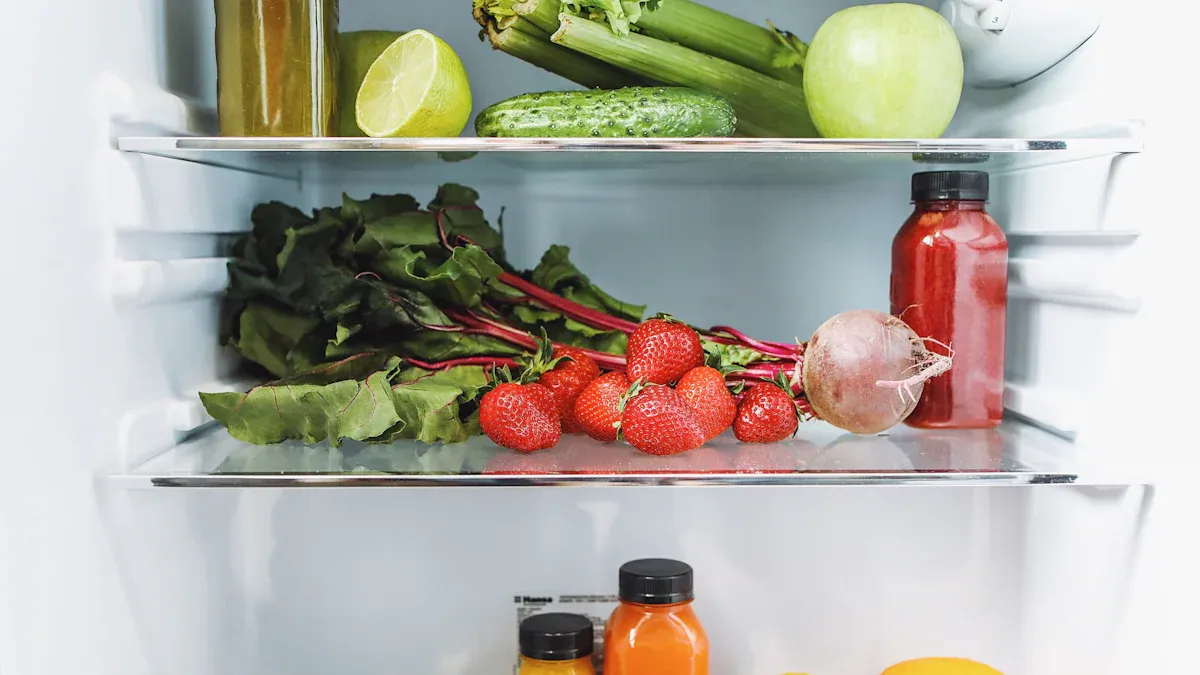Practical Differences You Must Know in 2025
Table of Contents

You stand before the fridge, yogurt in hand. The date was yesterday. Do you eat it or toss it? This confusion causes 88% of people to throw away good food. Understanding the practical differences in food labels is your solution. It all comes down to one simple rule for food safety and shelf life.
A
Use-Bydate is about food-safety. ABest Bydate is about food quality.
Knowing this difference helps you master your kitchen. You can protect your health, reduce waste, and save money by understanding a product’s true shelf life.
THE PRACTICAL DIFFERENCES IN DATE LABELS

The confusion between food date labels costs you money and creates waste. Understanding the practical differences is simple. One date is for safety. The other is for taste. This knowledge helps you master your kitchen’s shelf-life cycle.
SAFETY VS. QUALITY
You should view a Use-By date as a strict deadline. This date is about safety. It applies to foods that can grow harmful bacteria, even in the fridge. A key concern is Listeria, a pathogen that thrives at cold temperatures, unlike Salmonella. Ignoring this expiration date puts your health at risk.
A Best By date tells a different story. This date is the manufacturer’s suggestion for peak quality. After this date, the food’s quality may decline through processes like oxidation. You might notice changes:
- Mayonnaise can develop a sour odor.
- Blueberry jam might turn slightly brown.
- Cereal or chips may lose their crispness. The food is likely still safe to eat, just not at its best. Your senses are your guide to its remaining shelf life.
Government agencies like the FDA and USDA encourage a standard “Best if Used By” phrase for quality. However, federal rules do not require it for most food. This lack of a standard is why consumers often find the date labels on a product’s shelf life confusing.
WHY IT MATTERS IN 2025
Knowing these practical differences is more than a kitchen hack; it is a vital habit for 2025. Reducing food waste is one of the single most effective actions you can take to fight climate change. When you throw away good food, it rots in landfills and releases methane. This gas is a powerful driver of global warming.
Your understanding of date labels directly impacts this problem. Experts estimate that clear expiration dates could prevent over 400,000 tons of food from reaching landfills each year. This simple change in your routine helps conserve massive amounts of water and reduces harmful emissions. Making smart choices about a product’s shelf life protects your health, your budget, and the planet.
UNDERSTANDING FOOD SHELF-LIFE
A food’s shelf-life is its safety timeline. Manufacturers conduct detailed shelf life studies to determine this period. They set a Use-By date to give you clear shelf life guidance. Your home environment also plays a big role. Temperature is a critical factor. An increase of just a few degrees in your fridge can reduce a product’s shelf-life by up to 50%. Proper storage is your first line of defense in protecting the shelf-life of your food. This helps you get the most value and safety from every item. Understanding the product’s true shelf-life is key.
SAFETY-CRITICAL FOODS
You must pay close attention to certain foods. These are highly perishable items where harmful bacteria can grow quickly, even when refrigerated. Ignoring the date labels on these products creates a serious food safety risk.
These safety-critical foods include:
- Fresh meat, poultry, and fish
- Smoked fish and cured meats
- Milk, cream, and soft cheeses
- Prepared salads and sandwiches, like deli items or pasta salads
- Ready-to-eat meals that require refrigeration
For example, ready-to-eat products like READY MEALS PESTO BOWTIE PASTA SALAD have been recalled for Listeria contamination. This shows the real danger of consuming these items past their expiration. The European Union legally requires a Use By date on such perishable food. The United States, however, only federally mandates a Use-By date for one specific product.
THE ‘USE-BY’ RULE
The Use-By rule is simple and non-negotiable. You must discard any food that has passed its Use-By date. Do not eat, cook, or freeze it. This is a strict food-safety deadline, not a suggestion. The only exception to federal date labels in the U.S. is infant formula. You should never use infant formula after its Use By date. This ensures the product contains the correct nutrients for a baby’s health.
Manufacturers use rigorous science to set a product’s shelf-life. These shelf life studies are not guesses. They use multiple methods to find the exact point where a food may become unsafe. This process determines the final expiration date.
How Manufacturers Determine Shelf-Life
Companies use a combination of tests to establish a safe and accurate shelf-life:
Method Description Microbiological testing Detects and monitors the growth of harmful bacteria and mold over the product’s shelf life. Challenge Testing Intentionally introduces pathogens to the food to see how well it resists bacterial growth during its shelf life. Chemical analysis Examines changes in the food’s composition, like pH and water activity, during its shelf life. Real-Time Shelf Life Testing Stores the food under normal conditions to observe actual changes over its entire shelf life. Packaging Studies Evaluates how different packaging affects the product’s shelf life and safety.
This scientific backing is why you must always trust the Use-By date. It is the final word on the food’s shelf-life. Following this rule is the easiest way to prevent foodborne illness.
THE ‘BEST BY’ DATE EXPLAINED
You can think of the best by date as a friendly suggestion from the manufacturer. It is not a safety deadline. This date simply tells you when the product will have its best flavor and quality. After this date, the food’s journey is not over. Its shelf-life continues, though its peak quality may begin to fade. This is a key difference from a strict expiration date.
WHAT ‘BEST-BY’ REALLY MEANS
The best-by date is all about the manufacturer’s promise of peak performance. Government agencies and food producers are working to make these date labels clearer for you. The USDA and FDA encourage companies to use the phrase “Best if Used By.” This helps you know the date is about quality, not safety. Some states are making this even simpler. California, for example, passed a law requiring “BEST If Used By” for quality and “USE By” for safety on date labels.
This focus on quality means different things for different foods. A manufacturer determines peak quality based on the specific product you place on your shelf. The best by date reflects the ideal experience they want you to have.
How Manufacturers Define Peak Quality
Food Category Manufacturer’s Definition of ‘Peak Quality’ Canned Foods The date indicates when the food will have the best taste and texture. The food itself remains safe on the shelf for years if the can is undamaged. Dry Foods (e.g., pasta) These items have a very long shelf-life due to low moisture. The date is a rough guide for quality, but they are safe to eat long after. Frozen Foods The date on frozen food signals when it might start to lose flavor or develop freezer burn. It is not a safety indicator for the product’s life.
Understanding this helps you see the true shelf-life of your food. The best by date marks the end of the food’s guaranteed peak quality, not the end of its useful life.
ASSESSING POST-DATE QUALITY
When a food passes its best by date, you become the quality inspector. Your senses are the best tools to determine if a food is still good to eat. Before you throw something away, perform this simple three-step sensory check to extend its shelf-life.
- Sight 👀: Look at the food closely. Do you see any mold? Has the color changed dramatically? For dairy products, a bubbly appearance or bloating of the package are clear warning signs. If it looks normal, move to the next step.
- Smell 👃: Open the package and give it a sniff. Your nose knows when something is wrong. A sour, rancid, or “off” smell means spoilage bacteria have taken over. You should discard the food. If it smells like it should, you can proceed.
- Touch 👉: Check the food’s texture. Is your yogurt slimy? Are your crackers soft instead of crisp? While a stale chip is a quality issue, a slimy texture is a sign of spoilage. Trust your judgment.
Many foods, especially those on your pantry shelf, have a very long life. Their quality might change, but their safety does not.
The USDA confirms that most shelf-stable pantry foods are safe indefinitely past their
best bydate. Canned goods can last for years if the can is not rusted or dented. Packaged items like cereal, pasta, and cookies are also safe beyond theirdate labels, even if they become a bit stale. This extends the food’s shelf-life and saves you money.
You might notice your favorite chips have lost their crunch or your jam is not as vibrant. These are signs of declining quality, not danger. By using your senses, you can confidently decide what to keep and what to toss, giving every food item its full life.
OTHER COMMON FOOD LABELS
Beyond the main two, you will see other date labels on your food. Understanding these helps you make even smarter decisions about what is on your shelf. These labels are also not about safety but provide helpful context for a product’s life.
‘SELL-BY’ DATES
You will often see a sell by date on perishable items like milk or meat. This date is not for you. It is a message for the grocery store.
This practice began in the 1970s as a tool for stores to manage their shelf stock. Unfortunately, many people mistake the sell by date for a safety deadline. This confusion leads to throwing away perfectly good food. The sell by date simply ensures you have a reasonable time to use the product at home. For example, you can safely use ground beef for 1 to 2 days after its sell by date if you store it properly. The sell by date marks the end of its time on the store shelf, not the end of its useful life. Understanding this extends the product’s shelf-life in your home.
‘FREEZE-BY’ DATES
The Freeze-By date is another helpful suggestion for extending a food’s shelf-life. This date tells you the last day to freeze an item to maintain its peak quality. Freezing is like pressing a pause button on the food’s life.
Here is what you need to know about freezing:
- Safety First: Storing food at 0°F deactivates microbes. This makes it safe to eat almost indefinitely.
- Quality Over Time: While safe, the food’s quality may decline after a long time on the freezer shelf. It might lose flavor or develop freezer burn.
- Extend Shelf-Life: Freezing food before or on its
Freeze-Bydate is a great way to preserve its texture and taste for a longer life.
This simple action dramatically extends a product’s shelf-life. It is one of the best ways to reduce waste and get the most value from the food you buy. These date labels give you power over your food’s life cycle.
SMART FOOD STORAGE AND SAVINGS

Smart storage turns your kitchen into an efficient, waste-free zone. You can extend the life of your food and save money with a few simple habits. These practices help you get the most value from every item on your shelf.
PANTRY MANAGEMENT TIPS
A well-organized pantry is your first step. You should use the “First-In, First-Out” (FIFO) method. This is a simple system for your shelf. When you buy new groceries, place them at the back of the shelf. Move older items to the front of the shelf. This ensures you use food before its quality fades, extending its shelf-life. You can keep your shelf organized by grouping similar items together. This makes everything on your shelf easy to find.
Pro Tip 💡 For a high-tech approach, you can use a pantry app. Apps like
CozZohelp you scan barcodes, track expiration dates, and manage your shelf inventory. These tools help consumers see what they have, preventing duplicate purchases and reducing waste. Many consumers find these apps help them stick to a budget.
This organized shelf system gives every item its full life. It is a core principle that builds on the knowledge from shelf life studies.
EXTENDING USABILITY SAFELY
You can safely extend a food’s shelf-life beyond the date label. Freezing is one of the best methods. It acts like a pause button for the food’s life. You should freeze items before their Use-By date to preserve quality. Always use airtight containers or freezer bags. This simple step prevents freezer burn and protects the food’s texture and flavor. These are great food safety tips.
Proper storage also makes a huge difference for fresh produce.
- Separate certain fruits and vegetables. Keep ethylene-producing fruits (like apples and bananas) away from sensitive greens on your counter or shelf. This prevents premature ripening and extends their shelf-life.
- Give items room to breathe. Store potatoes and onions in a cool, dark place with good airflow, not in plastic bags on a shelf.
These methods, informed by shelf life studies, empower consumers to maximize a product’s shelf-life. You can confidently extend the life of your food.
You now know the practical differences in food labels. The rule is simple: always follow the use-by date for safety. For a best by or best-by date, trust your senses. This knowledge empowers you in 2025. You can confidently manage your shelf and extend a food’s life.
Your choices matter. You protect your health when you respect the
use bydate. You save money and cut emissions. Understanding these practical differences and theuse byrule is a powerful modern habit. Never use food past itsuse-bydate, and always check theuse bydate first.
FAQ
What if a food looks fine but is past its Use-By date?
You must throw it away. The Use-By date is a strict safety deadline. Harmful bacteria like Listeria can grow without any visible signs. Your senses cannot detect this danger. Always prioritize your health and discard the food.
Can I eat canned food past its Best By date?
Yes, you likely can. Canned goods have a very long shelf-life. The Best By date refers to quality. The food may lose some flavor or color. You should check the can first. Make sure it has no dents, rust, or swelling.
Does the “sniff test” work for all foods?
No, it does not. The sniff test helps you judge quality for foods past their Best By date.
You should NEVER use your senses to check food past its
Use-Bydate. These foods can be unsafe to eat even if they look and smell normal.
What is the only food with a federally required Use-By date in the US?
The U.S. government only requires a Use-By date for one product.
Infant Formula
This rule ensures the formula contains the right amount of nutrients for a baby’s health. You should never use formula past this date.

Poseidon
Master of Nutritional Epidemiology, University of Copenhagen, Herbal Functional Nutrition Researcher
Focus: The scientific application of natural active ingredients such as Tongo Ali, Horny Goat Weed, and Maca to sexual health and metabolic regulation.
Core Focus:
Men: Use a combination of Tongo Ali (an energizing factor) + Maca (an energy reserve) to improve low energy and fluctuating libido.
Women: Use a combination of Horny Goat Weed (a gentle regulator) + Maca (a nutritional synergist) to alleviate low libido and hormonal imbalances.
Stressed/Middle-Aged Adults: This triple-ingredient synergy supports metabolism, physical strength, and intimacy.
Product Concept:
Based on traditional applications and modern research (e.g., Tongo Ali promotes testosterone-enhancing enzyme activity, and icariin provides gentle regulation), we preserve core active ingredients and eschew conceptual packaging—using natural ingredients to address specific needs.
Simply put: I'm a nutritionist who understands "herbal actives." I use scientifically proven ingredients like Tongo Ali, Epimedium, and Maca to help you make "sexual health" and "nutritional support" a daily routine.
